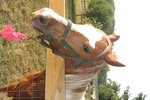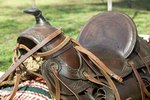A horse's shoulder injury can be difficult to diagnose. Pain originating from another location such as the lower leg can be misdiagnosed as shoulder pain. Injury to the shoulder can also be difficult to treat due to its location and the horse’s dependency on its mobility. Injury to the shoulder can occur from falls, a bad step, puncture wound or impact with another horse or solid object. These injuries can result in anything from a deep bruise to a fractured bone.
Diagnosis and Treatment
Assess symptoms to accurately locate the point of injury or pain. Apply pressure to the shoulder area to observe signs of discomfort. Look for swelling in the area of the joint. Other signs are reluctance to move the leg forward, or once the leg is forward during motion, the leg will be put down earlier than normal, not completing a full stride. With a chronic or ongoing case, the chest and shoulder muscles will atrophy (waste away) due to lack of use. Apply a local anesthetic to the shoulder area of the horse. If the animal moves better or pain symptoms decrease, it is a good indication that the shoulder is the problem.
Determine the problem. Although rare, arthritis in the shoulder can occur especially in ponies and miniature horses as it is not uncommon for them to be born with shoulder dysplasia. Dysplasia happens when the socket that the shoulder bone fits into is too shallow. Anything from arthritis to bone dislocation can occur. Treatment involves surgically adding plates and screws across the joint.
Puncture wounds can cause septic (infected) arthritis in full-sized horses. Arthritis may also develop in the horse’s shoulder when bone disease is present between the bone and cartilage. A result of this developing disease may cause cysts to form or sections of cartilage to become cracked, form flaps or break off into the joint capsule. Treatment includes flushing the joint and using antibiotics both systemically (circulatory system) and intra-articularly (within the joint). Arthroscopic surgery is an option, as well as regular injections of hyaluronic acid (normal joint fluid).
Injury to the soft tissue is the most common shoulder injury. The bicipital bursa (fluid-filled sac) sits between the bone. This structure is covered by tendons and muscles. If any of these areas become inflamed or torn, pain ensues. Injury normally occurs when the horse’s leg is behind the shoulder while the shoulder is flexing to bring it forward. Injecting the bicipital bursa with a corticosteroid such as cortisone is the first step in treatment. A veterinarian may also suggest incorporating an anti-inflammatory drug and equine massage therapy. This should be followed up with rest, possible stall confinement and cold-hosing the shoulder area.
References





